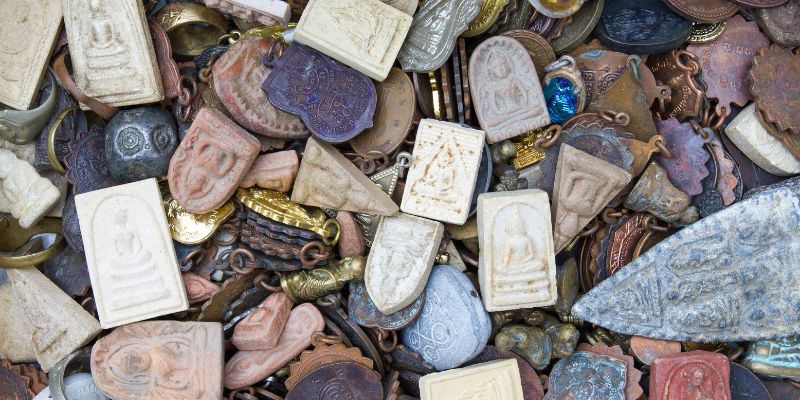The relationship of material science and spiritual alchemy gives rise to fascinating questions: How do different materials serve as conduits and repositories for human intentions and energies? The answer lies at the intersection of molecular structure and metaphysical resonance, a blend of the arcane and the empirical that transcends ordinary understanding.
A Matter of Atoms and Intentions: Gold and Silver
Gold and silver, the epitome of precious elements, stand at the crossroads of physics and spirituality. It’s no coincidence that their chemical stability and molecular composition make them exceptional materials for the storage and projection of energies. Each atom, in its sublime configuration, serves as a micro-vortex, capturing and amplifying the intentions bestowed upon them during consecration ceremonies. In essence, they function as divine data storage units, encoding and broadcasting human intentions and prayers.
Gold and silver, elements that share not just a chemical affinity but also a sacred prominence across traditions. In Hinduism, gold is associated with the divine principle, the highest form of the material world that aids in the purification of the soul. Similarly, Thai spiritualism venerates these metals for their purity and divine attributes. Within the scope of Thai amulets or ‘Pra Kreuang,’ these precious metals are often used to harness and channel protective and beneficial energies.
The Subtleties of Copper and Brass
Copper and brass hold a different, albeit equally complex, story. Their atomic structures are sturdy, rendering them excellent conduits for spiritual energies. When a sacred object made of copper or brass is consecrated, the energy does not merely bounce off its surface; it penetrates into the deeper molecular configurations, lodging itself securely. Over time, the object becomes a potent reservoir of stored intentions, ready to be tapped into or emanated outward.
Copper and brass, one mustn’t overlook their significance in Buddhist and Thai rituals. Thai temples frequently employ brass bells and gongs, which are believed to ward off evil spirits. Likewise, Tibetan Buddhism uses brass in the crafting of ritualistic items like singing bowls and statues, elevating the metal’s role as a conduit of spiritual energies. These traditions intuit that copper and brass have a propensity to become saturated with spiritual power, serving as metaphysical vessels for intentions and prayers.
The Magnetic Charm of Sacred Iron Ore
Sacred iron ore takes conduit and storage capacities to a new dimension. Its magnetic properties, inherent in its molecular makeup, mean that it not only attracts physical particles but also draws in metaphysical energies. These energies, when channeled through sacred rites, are imprinted onto the very molecules of the iron, creating a sacred object that functions as both a conduit and a storage medium for spiritual energies.
The allure of sacred iron ore isn’t limited to its magnetic qualities; it also holds a particular fascination in Thai spirituality. Known as ‘Lek Lai,’ and ‘Lek Nam Phi’ these mysterious substances are said to be both fluid and solid and believed to possess potent spiritual properties. Hinduism offers a similar sentiment through mythologies that venerate divine weapons made from heavenly metals, substantiating the idea that these materials act as potent transmitters and storers of both earthly and divine energies.
The Elemental Purity of Earth, Clay, and Soil
In our ceaseless quest for understanding the spiritual realm, the emphasis often lies on elements that are rare, costly, or ethereally beautiful. Yet, the humble constituents of our natural world—earth, clay, and soil—hold a unique, elemental purity that has been recognized and revered across a wide range of spiritual traditions, including Hinduism, Buddhism, and Thai spirituality. These materials are far from mundane; they are, in fact, the very substratum of life as we know it.
What lends these materials their unique capability to serve as spiritual repositories? It’s a combination of their natural structure and the symbolic weight they carry. Earth, clay, and soil have a complex, porous structure at the microscopic level, allowing them to absorb and store energy. As these materials absorb the spiritual energies during consecration ceremonies, they undergo a transformation, evolving into something more than just physical matter. Their granular forms become matrices of potent spiritual energy.
And let us not overlook the symbolic resonance of these materials. Earth represents the foundational element in many spiritual and mythological frameworks—it is Terra Mater, the mother of all life. In Hindu cosmology, the earth is associated with its life-giving capabilities. In Buddhist thought, the very act of touching the earth, as the Buddha did under the Bodhi tree, can serve as an anchor to reality and enlightenment.
When these earthly materials are incorporated into sacred objects, their elemental nature aligns perfectly with their newfound spiritual purpose. For instance, many amulets or statues use soil or clay in their base, acting as a grounding core that serves both a physical and a metaphysical function. This base becomes a storehouse, a reservoir of concentrated intentionality and spiritual energy. It’s a symbiotic relationship—the earth gives form to the statue or the amulet, and in return, the consecrated object imbues the earth with spiritual significance.
Earthly Resonance: Wood
In the case of wood, its simpler, organic molecular structure lends itself more to the role of a spiritual storage unit rather than a conduit. Its cellular makeup has a natural capacity to absorb and store energies, making wood an organic cache for imbued intentions. Though it may not broadcast these intentions as effectively as metals, its rooted connection to Earthly energies grants it a unique capacity to hold and cradle spiritual resonance.
Wood, often overlooked in its spiritual potential, holds a revered place in Thai spiritual practices, where wooden amulets and representations of Buddha are crafted from specific types of trees believed to have inherent spiritual qualities. Likewise, in Hinduism, specific wooden items like the sacred Tulsi beads are used for meditation and prayer, reinforcing the idea that wood’s molecular simplicity is a blessing, making it a humble yet effective spiritual storehouse.
Hardened Receptacles: Ivory and Tooth
The dense molecular structure of ivory and tooth grants them extraordinary capacity for both channeling and storage. Like the metals, these materials act as conduits, channeling energy through their unique configurations. However, the organic complexity within their structures allows them to also function as potent storage units, capturing and holding spiritual energies with remarkable efficacy.
Venturing into the dense molecular realm of ivory and teeth, Thai spiritualism offers an array of talismans and amulets made from these materials. Its dense molecular structure serves as a labyrinthian storage unit, capturing and locking in spiritual energies for prolonged periods.
Syncretic Composites: Resin Mixes
Composite resins present a remarkable case of how artificially engineered materials can be transformed into spiritually potent items. While the resin alone would offer limited storage or conduit capabilities, its admixture with sacred elements like gemstones or iron ore alters its molecular matrix. This creates a hybrid structure where spiritual energies can flow and lodge themselves, thus transforming a once-mundane material into a spiritually active entity.
Spiritual DNA: Human Bones
Human bones, replete with the intricate helixes of DNA, serve as unparalleled vessels for spiritual energies. DNA, as a molecular blueprint of life, offers a complex framework for the lodging of intentions and energies. The bones, therefore, function as repositories of spiritual memory, capable of both holding and projecting the imprinted energies.
In the profoundly mystical realm of human bones, deeply significant in Thai animism and spirituality, where they’re believed to house the essence of the departed soul. Combined with Buddhist doctrines that explore the cycle of life, death, and rebirth, bones are viewed as the ultimate spiritual vessels, imbued with the complex energetic signatures that DNA holds.
The Grounding Factor: Statue Bases
Finally, the base of a statue or amulet provides another layer to this intricate relationship between materiality and spirituality. Often filled with soil or other organic matter, the base functions as a grounding unit that stores and consolidates energies. It acts as a spiritual anchor, providing a space where the energies imbued in the object can collect, amplify, and eventually radiate outward.
The bases of Thai amulets or sacred statues often incorporate elements like soil from seven different cemeteries, seven river junctions, or other spiritually significant locations. This practice aligns with Buddhist philosophies that highlight the interconnectedness of all elements and emphasizes the grounding essence of Earth.
So here we stand, at the captivating confluence of science and spirituality, where materials are not just lifeless elements but dynamic matrices—each with a distinctive molecular and mystical personality. They are both conduits and storage facilities, functioning at the intersection of the tangible and the intangible, to channel, store, and emanate the profound energies of human intention and divine grace.








